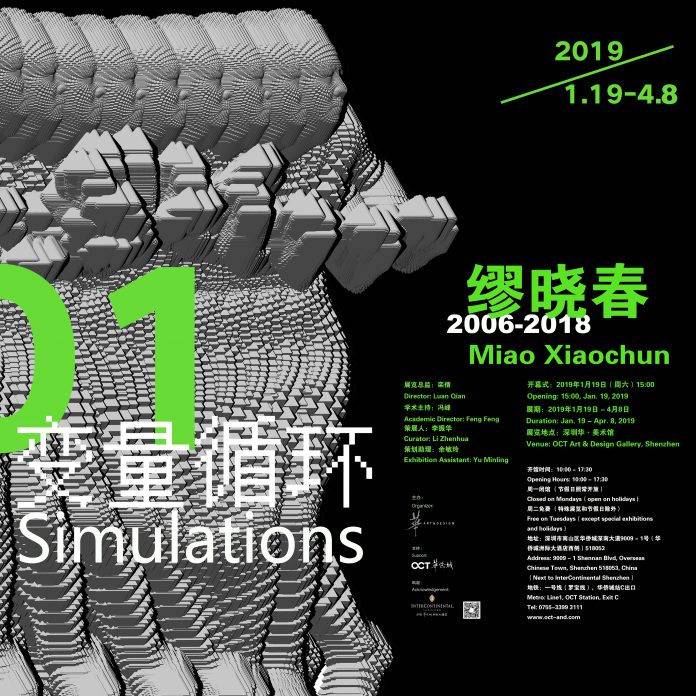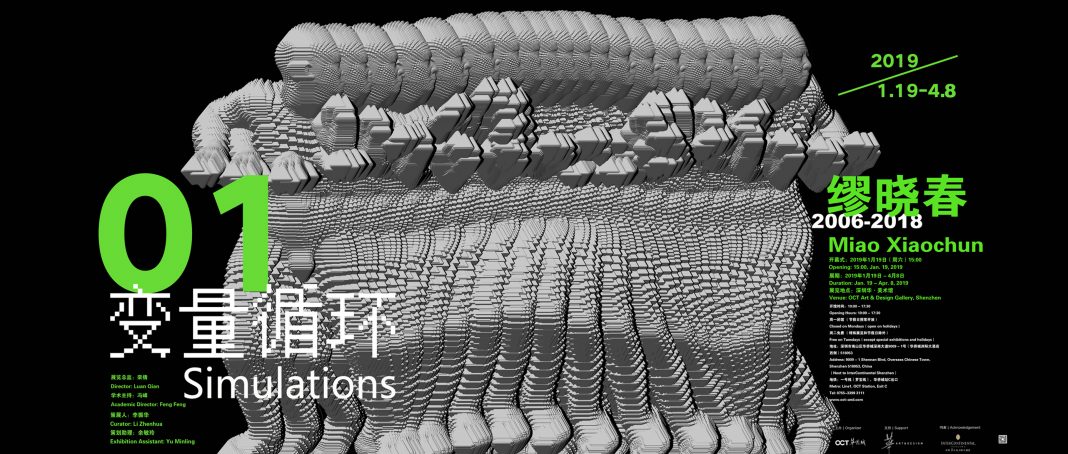
由华·美术馆主办,独立策展人李振华策划的展览“01 变量循环:缪晓春 2006-2018”,即日起至4月8日在深圳华·美术馆对公众开放。此次展览是对艺术家缪晓春自2006年以来创作的全面回顾,旨在呈现缪晓春在创作中如何思考媒介、科技和观念之交互。
The solo exhibition, “01 Simulations: Miao Xiaochun 2006-2018”, curated by Li Zhenhua, an independent curator, is hosted by OCT Art & Design Gallery in Shenzhen and is open to 8th April, 2019. As a comprehensive review of Miao Xiaochun’s art works created between 2006 to 2018, the exhibition is staged to demonstrate the artist’s exploration of the interaction among media, technology and concepts.

关于缪晓春 | Who is Miao Xiaochun
缪晓春于中央美术学院和德国卡尔斯卢厄国立设计学院(Staatliche Hochschule für Gestaltung Karlsruhe)任教,以摄影和多媒体艺术创作而享誉国内外,他借助数字手段形成其独特艺术风格,创造多样作品形式。从观念摄影《在德国朋友家做客》(1998)到开创性的三维动画《虚拟最后审判》(2005 – 2005),缪晓春完成了图像和技术上的延续,从文化冲突到自我肖像的浮现,质疑当下之存在。他的创作和工作方法,影响了许多青年艺术家和动画工作者。他常用跨领域的多媒介手段制造出气势宏伟的现实、拟真或纯数字景象,作品的灵感无界。对中西方传统绘画或经典文化元素挪用,通过现代视角与科技手段,打破传统和当代的时空界限。
Miao Xiaochun is teaching at the Central Academy of Fine Arts, China and Staatliche Hochschule für Gestaltung Karlsruhe, Germany. He is renowned in the world for its photography and multi-media artistic works. Through leveraging the digital tools, Miao has shaped his unique artistic style delivered in various forms. From his conceptual photography piece, As a Guest of German Friends (1998), to the groundbreaking 3D animation work, The Last Judgement in Cyberspace (2005-2005), Miao realized the succession of image with technology and moved from cultural conflicts to the emergence of his self-portrait to question the existence at present. His approach has influenced many young artists and animation creators. Through the frequently adopted cross-disciplinary, multimedia methods, Miao has depicted magnificent scenes of reality, simulation or pure digital views with inspirations knowing no boundaries. The appropriation of the elements from both Chinese and Western paintings or classic cultures breaks through the space-time separation between the classic and contemporary creation from a technology-enabled modern perspective.
“《最后审判》是米开朗基罗绘制于罗马西斯廷教堂穹顶的壁画,它同时也是一部宏大的空间史诗,而缪晓春把它转换为一种后现代版本。这幅壁画离北京如此遥远,在地球的另外一端,产生于基督教统治下的世界帝国的中心。对于一个中国艺术家来说,这幅壁画在当下那些被图片愚弄之人的文化记忆中占有着一个核心位置。在日本,这幅壁画在二十多年前就被从黑白图片转为印刷精美的作品全集。而缪晓春却从没见过这幅壁画,他只见过画册中那些包含细节的局部图片,即便如此,这已足以让他在虚拟世界中,对这幅受新柏拉图主义影响的人物色彩结合完美的作品进行转换。这些具有多义性的图片在缪晓春那里得到了新解,它被转换成他本人关于想象和生存空间的现代梦想,这一空间以一种游戏姿态和与超现实的联系促生了新的图片。缪晓春在2006年创作了《虚拟最后审判》,这是一部包含了系列图片和庞大的三段式视频的作品,在这部作品中,缪晓春让我们看到,如果用一种近乎自省的角度转换来看这部作品,其意义结构会发生怎样的转变。艺术家用自己的形象替代了米开朗基罗作品中的近四百个人物,在他的带领下,我们似乎和他一起、和他的想象力一起,进入了西斯廷教堂。”——《后现代的就是如此》,格雷戈尔·扬森,翻译:黄晓晨(原载乌塔·格罗森尼克,亚历山大·奥克斯:《缪晓春 2009-1999》,杜蒙出版社,科隆,2010)
“The Last Judgment, Michelangelo’s fresco from the Sistine Chapel in Rome, is also a gigantic cyber epic that Miao transferred to a post-modern worldview. The fresco is located far from Beijing, on the other, Western side of the globe, and in the old center of the Christian world empire. For the Chinese artist, it represents at the same time a significant part of the cultural memory of those today mad about images. He never saw the actual work, which was cleaned a good 20 years ago to a high polish by Japanese restorers: but detailed illustrations from art volumes were sufficient to enter virtually the neo-Platonic mix of figures and colors of The Last Judgment. These images, once rich in iconographic meaning, become in Miao’s work dreams of his own space of imagination and life translated to the contemporary that can be playfully transformed with surreal combinations into new images. In the photograph series and the colossal video triptych The Last Judgment in Cyberspace from 2005, Miao shows how an almost introspective change of perspective changes the foundational construction of meaning in the work. The recasting of Michelangelo’s almost 400 figures with the alter ego of the artist takes on a hybrid appearance, since we enter the Sistine Chapel with him, with his imagination.” –Post-History’s Being Just So, by Gregor Jansen (original article: Uta Grosenick, Alexande Ochs, Miao Xiaochun 2009-1999, Dumont, Cologne, 2010)
2006年以来,缪晓春用电脑数码技术探寻新的艺术表达,尝试人脑与电脑共同思考,人手与鼠标协同合作。他认为,计算机硬件强大的计算能力和软件具有无限变幻的可能性,算法不仅仅只是生成一串数据,也是生成的图像作品,是虚拟世界和现实世界的交融。缪晓春的个人肖像被简化为抽象动画人物,试着表述个人和集体之依存,他对身体的解构重组,也是艺术家对自我存在和社会构成之疑惑。
Miao started his exploration of new art forms with digital technology in 2006, trying to combine the brain power of human and the computer and coordinate human hands with the mouse. In his opinion, the impeccable computing capability supported by the hardware and the software can generate infinite possibilities, and the algorithm performs not only data generation but also image creation that interfaces the virtual world and the reality. The portrait of the artist himself has been abstracted into an animated figure to express the interdependency between the individual and the collective. The deconstruction and reconstruction of himself also shows his confusion over aseity and the existing social structure.
“如同很多当代艺术家一样,缪晓春也是一位历史学家,当然,这不是在科学的意义上,而是在艺术的意义上说的。当他将艺术史上的诸多‘界面’融入到自己作品中时,他也扩展了问题的框架:当代艺术在技术和社会文化层面上为我们的文化记忆做出了怎样的贡献?当缪晓春十分用心地运用3D技术中相互之间不无矛盾的诸多可能性创作了他的《从头再来》时,我们其实又重新遭遇了一个老问题,那就是如何在爱神和死神之间寻找平衡的问题。随着社会的不断进步,我们制造出了越来越多的精致产品来获得满足,但是,对这一问题的追问却无可取代;同时,我们自身实际上也一直身处这问题其中。‘我们将往何处去?’这是缪晓春的3D模型在《虚拟最后审判》中以多种方式提出的问题。当我们试图以将两者分离的方式解决爱神和死神之间的冲突时,问题的答案或许是‘在那里其实没有那里。’进入到虚拟世界这个‘那里’,也许会带给我们一些勇气,让我们可以在虚拟象征世界和我们所处的尘世之间建立起一种更富建设性的关系。”—— 双重界面——缪晓春的《从头再来》,乌苏拉·帕南斯-布勒,翻译:黄晓晨(原载贝娅特·莱芬莎特《缪晓春-宏观狂》,路德维希博物馆,东八时区出版社,香港,2010)
“Like many contemporary artists, Miao Xiaochun is also a historian, not in a scientific sense, but in an artistic one. Therefore, when he incorporates the artistic interfaces of the tradition, he expands the frame of his interrogation of our technological and socio-cultural situation with his contribution of the artistic tradition to our cultural memory. That he includes, with extreme care, the ambivalent possibilities of 3-D animation into his construction of ‘RESTART’ could be taken as a new configuration of the unsolved question regarding the balance between Eros and Thanatos, a question that we cannot cede to the progress of ever newer forms of vicarious satisfaction by taking up ever more refined products and simultaneously a question that we as witnesses are involved in. ‘Where do we go?’ was the question posed in a myriad of ways by his 3-D imago in ‘The Last Judgment in Cyberspace’. If we wish to solve the conflict between Eros and Thanatos with the aid of a division, then perhaps the answer reads: ‘There is no There there’. Plunging into the ‘There’ of artistic cyberspace might provide us with the courage to find new, productive relations between the symbolic world and that of our earthly situation.” – Double Interface – Miao Xiaochun’s RESTART, Ursula Panhans-Bühle translated by Daniel Hoheisel (original article: Beate Reifenscheid, Miao Xiaochun – Macromania, Ludwig Museum, Timezone 8, Hong Kong, 2010)
01是一种计算机语言,在计算机内部,无脉冲被描述为0,有脉冲被描述为1。用户看不到计算机内部所进行的持续电子脉冲,能看到的只是一些稳定的图片和字符。“变量循环”可以被看作是所有媒介之间的相互衍生的进程。这是基于缪晓春创作思考和细节的一个内观式展览,展览将可见与不可见的空间进行转换,你会看到博斯(Hieronymus Bosch,1450 – 1516)、米卡朗基罗(Michelangelo Buonarroti,1475 – 1564)、爱德华·马奈(Édouard Manet,1832 – 1883)的经典图像,以及不断变换着尺幅和媒介细节的相似物。图像存在,因为你可以从其中阅读艺术历史和人。图像不在,因为你可以从细节去发现表象事物下之细节。发现缪晓春艺术生成的所有知识和媒介关系,以及不同媒介之间的运作。知识生产和艺术生产,空间探索和历史研究,美学手段和公众体验,都在这个展览中互为依存。
“01” is the language of computer. “0” is used when there is no impulsive wave, while “1” is used when there is. The users cannot see the continuous electronic pulses inside a computer but only the pictures and characters displayed stably on the screen. “Simulation” is the progression derived through the interaction among all media. Therefore, “01 Simulations” can be regarded as an introspective exhibition grounded on the thoughts and details of Miao’s creation, through which the visible and invisible spaces are converted into each other. The audience will find the classic images created by Hieronymus Bosch (1450 – 1516), Michelangelo Buonarroti (1475 – 1564) and Édouard Manet (1832 – 1883), and analogs whose sizes and media specifications are constantly changing. The images will come into existence when you recognize and read through the history and the people of art as depicted. However, the images will disappear when you start to observe the details under the superficial objects to discover all the knowledge, the relationships and the interaction among various media generated from Miao’s art. You will find in this exhibition the coexistence of the production of knowledge and art, the exploration of space and history, and the aesthetic means and public experience.
“雕塑能从许多面看,但绘画只能从前面看,设想一下,从背后看一张画会是什么样?从背面看米开朗琪罗的‘最后的审判’会是什么样子呢?我想,原先重要的人物都会变得不太显眼,反而是次要的处在边角的人物成为了主要角色,而画面原先的意义也发生了巨大的戏剧性的转变。也许这连米开朗琪罗本人也未曾设想过。”——缪晓春自述,缪晓春的《最后审判》,巫鸿,翻译:兰亭(原载巫鸿:《缪晓春:虚拟最后审判》画册,沃尔什画廊,芝加哥,2006)
“A sculpture can be looked at from multiple sides, whereas a painting can only be viewed from the front. Imagine what would happen if we looked at a painting from the back? How would Michelangelo’s The Last Judgment appear from behind? I think the figures considered important in the original work would become less conspicuous, while the secondary figures situated on the edges of the picture plane would assume principle roles. The original meaning of the fresco would be dramatically transformed. Perhaps even Michelangelo himself never imagined such a way of looking at his fresco.” – The Last Judgment in Cyberspace, by Miao Xiaochun; translated by Peggy Wang (original article: Wu Hung, Miao Xiaochun: The Last Judgment in Cyberspace, Walsh Gallery, Chicago, 2006)
此次展览将展出缪晓春近十二年用数字技术进行创作的摄影、绘画、刺绣、雕塑等作品,以及2017年开始持续创作发展的新作《陀螺舞》的图像(image)、运动(move)、动态(motion)、动机(motive),借由影像、装置与雕塑在空间中的形态,再次引申艺术家对存在与真实性持续探究。华·美术馆作为国内第一家设计美术馆,关注设计的实验性以及跨学科的创新力量,希望通过“ 01 变量循环:缪晓春 2006-2018 ”展览对未来、人与科技的探讨,与公众共同对新时代的艺术形态再次进行注视,并能够身在其中进行思维发散。今天,数字技术的使用不仅改变了人类的工作和生活方式,也改变着艺术的创作方式。此次展览及附属公共项目将通过多种方式和角度延展关于数字时代和人类自身发展的话题,它们或将提供一个提示,一个警示,一个预言……当我们讨论未来的时候,就已经开始在思考关于未来的不同选择。
This exhibition will present to the audience Miao Xiaochun’s videos, paintings, embroideries and sculptures among the works created with digital technology in the past 12 years, as well as the image, move, motion and motive of the new series of Gyro Dance, created since 2017 to further amplify the artist’s exploration of existence and authenticity through the patterns of the videos, installations and sculptures in the space. As the first gallery dedicated to design in China, OCT Art & Design Gallery always seeks the experimental and multidisciplinary endeavor in design innovation. We hope that the discussion about the future, human beings and technologies triggered by “01 Simulations: Miao Xiaochun 2006-2018” would target the attention of the public at the art forms in the new era again and allow divergent thinking during their experience with these works. Nowadays, the application of digital technology has brought changes to people’s life and work and is influencing approaches to artistic creation. The exhibition and affiliated public projects would tough widely upon the topics of the digital era and human development through multiple perspectives and approaches to serve as a hint, a warning or a prophesy. While we talk about our future, we have already started to think about the possibilities in it.
01 变量循环:缪晓春 2006 – 2018
01 Simulations: Miao Xiaochun 2006 – 2018
主办:华·美术馆
Organizer: OCT Art & Design Gallery
展期:2019年1月19日——4月8日
Duration: 19th Jan. – 8th April, 2019
展览地点:深圳华·美术馆
Venue: OCT Art & Design Gallery, Shenzhen





